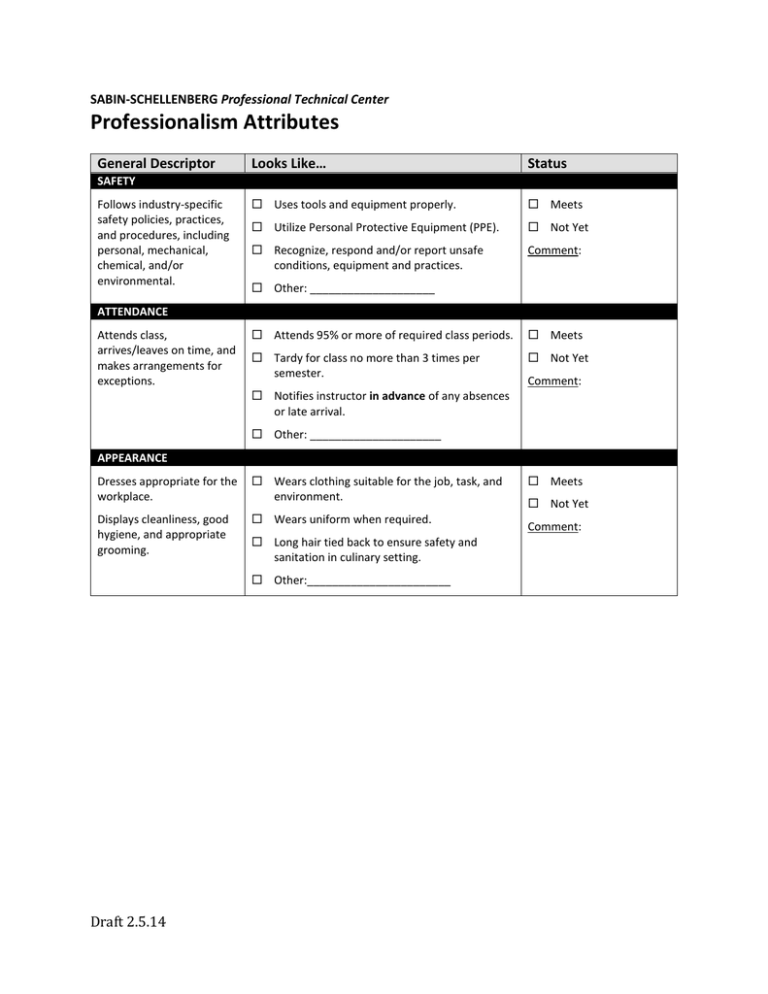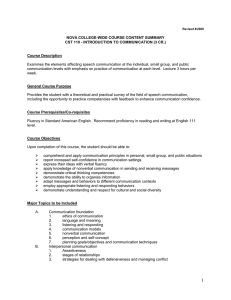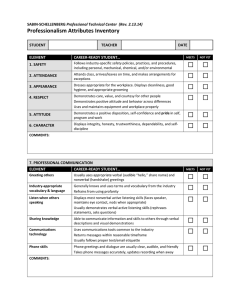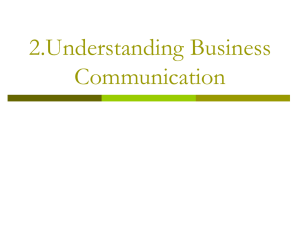Professionalism Attributes General Descriptor Looks Like…
advertisement

SABIN-SCHELLENBERG Professional Technical Center Professionalism Attributes General Descriptor Looks Like… Status Uses tools and equipment properly. Meets Utilize Personal Protective Equipment (PPE). Not Yet Recognize, respond and/or report unsafe conditions, equipment and practices. Comment: SAFETY Follows industry-specific safety policies, practices, and procedures, including personal, mechanical, chemical, and/or environmental. Other: ____________________ ATTENDANCE Attends class, arrives/leaves on time, and makes arrangements for exceptions. Attends 95% or more of required class periods. Meets Tardy for class no more than 3 times per semester. Not Yet Comment: Notifies instructor in advance of any absences or late arrival. Other: _____________________ APPEARANCE Dresses appropriate for the workplace. Wears clothing suitable for the job, task, and environment. Displays cleanliness, good hygiene, and appropriate grooming. Wears uniform when required. Long hair tied back to ensure safety and sanitation in culinary setting. Other:_______________________ Draft 2.5.14 Meets Not Yet Comment: SABIN-SCHELLENBERG Professional Technical Center Personal Attributes General Descriptor Looks Like… Evidence Options RESPECT Respect toward people: Demonstrate care, value, and courtesy for other people Demonstrate positive attitude and behavior across differences Treats everyone like they are the most important person in the building Refrains from harassment of any kind Practices active listening; speaks when appropriate Uses personal and social technology in the right time, place, and manner Respect toward things: Properly uses equipment and keeps workspaces clean and neat Use and maintain equipment and workplace properly Other: _____________ ATTITUDE Demonstrates a positive disposition, self-confidence and pride in self, program and work Displays a welcoming, friendly, and upbeat demeanor Does their best; produces quality work Smiles Other: _____________ CHARACTER Displays integrity, honesty, trustworthiness, dependability, and selfdiscipline Level 1: Self-evaluation report discussing how student demonstrated the attribute(s) in a school or class group project Level 2: Peer evaluation from a group project that includes specific discussion of attribute(s) Level 3: Letter of recommendation or other documentation from teacher, employer or other professional adult that includes specific discussion of attribute(s) Other: ___________ Keeps client information confidential Follows appropriate copyright laws Is truthful even when it hurts to do so Maintains appropriate interpersonal relationships in the workplace Refrains from taking things that belong to others Other: _____________ Evidence List (In the space below, list evidence used to demonstrate Respect, Attitude, and Character) Draft 2.5.14 SABIN-SCHELLENBERG Professional Technical Center Students use left-side check boxes Teachers use right-side check boxes Professional Communication Rubric EXCEEDS MEETS NOT YET Greeting others Consistently uses friendly, appropriate verbal (audible “hello,” share name) and nonverbal (smile, firm handshake) greetings S T Usually uses appropriate verbal (audible “hello,” share name) and nonverbal (handshake) greetings S T Greetings may lack volume, appropriateness, proper form (weak handshake), or consistency S T Industryappropriate vocabulary & language Consistently and accurately uses industry-specific terms and vocabulary Refrains from using profanity and addresses inappropriate language use by others Generally knows and uses terms and vocabulary from the industry Refrains from using profanity Does not use terms and vocabulary from the industry Uses profanity or unprofessional language S Listen when others speaking Consistently displays many nonverbal active listening skills (faces speaker, maintains eye contact, nods when appropriate) Consistently demonstrates verbal active listening skills (rephrases statements, asks questions) Communications technology Draft 2.5.14 T S T Often appears distracted through nonverbal cues (looking away, looking bored, doing something else while someone is talking) Not able to use reflective statements or ask appropriate questions Effective and engaging at communicating information and skills to others through verbal descriptions and visual demonstrations S T Able to communicate information and skills to others through verbal descriptions and visual demonstrations Verbal sharing of information is unclear or ineffective; may not be able to demonstrate skills using hands-on demonstrations S T Efficiently uses all communications tools common to the industry Returns all messages promptly Consistently follows proper text/ email etiquette Uses communications tools common to the industry Returns messages within reasonable timeframe Usually follows proper text/email etiquette S Phone skills S Displays most nonverbal active listening skills (faces speaker, maintains eye contact, nods when appropriate) Usually demonstrates verbal active listening skills (rephrases statements, asks questions) S T S Sharing knowledge T COMMENTS T T Phone greetings and dialogue are consistently clear, audible, and friendly Takes phone messages accurately, updates recording when away Able to redirect/transfer callers to another line with appropriate explanation S T S S T T Phone greetings and dialogue are usually clear, audible, and friendly Takes phone messages accurately, updates recording when away S T S T Has difficulties using some communications tools Does not return messages promptly At times uses unprofessional language, slang, or images when using tech tools S T May be hard to hear, understand, or may use inappropriate greetings on the phone Messages may be inaccurate or illegible S T SABIN-SCHELLENBERG Professional Technical Center Teamwork Rubric Participation Students use left-side check boxes Teachers use right-side check boxes EXCEEDS MEETS NOT YET Actively participates in and contributes to group tasks, providing leadership when needed Actively participates in and contributes to group tasks Sits back and allows others to do the work Fulfills assigned group role and allows others to do their job Does not complete their assigned tasks Fulfills assigned group role, allows others to do their job, helps others and shows initiative at times S Interactions with others T Works well with others and clearly respects the differences of others; makes all group members feel valued Cooperates and does not cause conflict; helps resolve group disputes S Communication in a group setting Communicates effectively with the group through active listening, taking turns, and facilitating group discussions as appropriate S Draft 2.5.14 T T S T Works well with others and respects differences Doesn’t always get along with others, at times creates conflict within group T Able to communicate with the group through active listening, taking turns, and contributing to open discussions S T Has a hard time working with others, especially those who are different Cooperates with others in the group and does not cause conflict S S COMMENTS T S T Doesn’t say much or listen well when working with a group S T SABIN-SCHELLENBERG Professional Technical Center Productivity Rubric Completing tasks Students use left-side check boxes Teachers use right-side check boxes EXCEEDS MEETS NOT YET COMMENTS Consistently completes work on time and following all requirements Usually completes work on time and as required Work is often late or incomplete S S Takes initiative to find additional work to do when required work is complete S Use of time T Devotes full attention to work during scheduled work time T Stays focused on work during scheduled work time Helps others avoid distractions and refocus on task at hand S Efficiency T S T T S Does not waste time or resources in doing their work Takes extra time to complete required tasks; may waste resources S S Finds innovative ways to be more efficient Draft 2.5.14 Often distracted and off-task during scheduled work time Personal issues and tasks get in the way of completing required work Does not waste time or resources in doing their work S T T T T SABIN-SCHELLENBERG Professional Technical Center Problem Solving Rubric Uses a structured process Research Creativity EXCEEDS MEETS NOT YET Begins by sketching out a detailed, logical plan and uses the plan to guide each step Makes a plan at the beginning and mostly follows it while solving the problem Uses a random problem solving approach that features lots of starts, stops, and missteps that could have been avoided S S Draft 2.5.14 T T Efficiently seeks, finds, and uses multiple sources of relevant information when searching for solutions Finds more than one kind of information source related to the problem at hand S S T Regularly develops unique, inventive ways to solve problems S Persistence Students use left-side check boxes Teachers use right-side check boxes T Suggests new ways to solve problems from time to time T S T Never gives up; views setbacks as a challenge to work harder and smarter Keeps working to solve the problem, even when roadblocks are frustrating the effort S S T T S COMMENTS T Unsure of where to go for information, or rarely uses more than one source S T Solutions are copies of those that have come before, even when a fresh approach is needed to a tough challenge S T Gives up pretty easily when the problem can’t be solved with a simple fix S T



